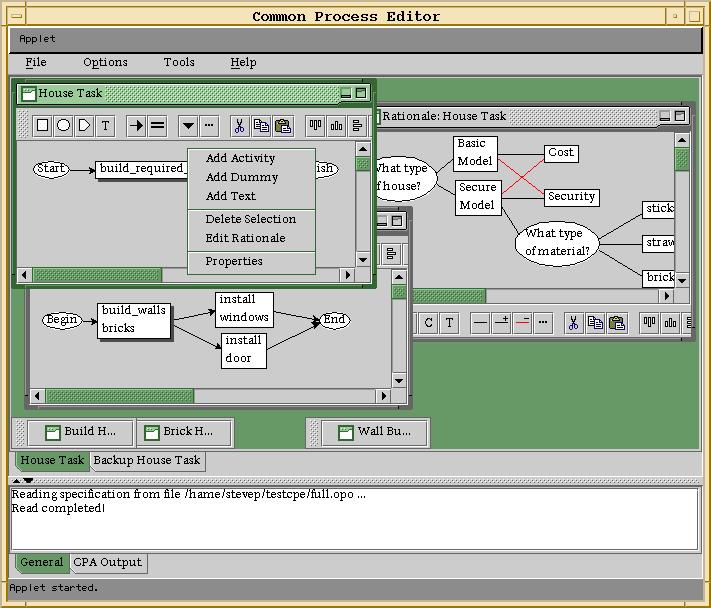The CPE provides java-based process visualization and editing
capabilities of newly synthesized processes and process knowledge. CPE
utilizes a translator which converts O-Plan plan output format into
the Common Process Language(CPL).
The CPE can be launched from the control panel or executed from a
command prompt in the installed directory:
"./cde". CPE runs as a java applet (using
appletviewer, which is part of the JDK) which means that it may
eventally be integrated into set of web pages and launched from a
browser, but most of the current browsers fail to provide adequate
support for the java api's. The O-Plan plan output format file which
was exported from O-Plan can be read into the CPE. See figure 1 for an
example of process editing session.

Figure 1 - The Common Process Editor
See the "{target dir}/docs/papers/" directory for the CPE users guide
which provides detailed information for working with the
editor. Eventually, plug-in translators will be developed for
exporting the process knowledge to WPDL, IDEF3, PIF, PSL.
- Running the translator from the command line.
CPE also provides access to its O-Plan Output->CPL translator on the
command line. For example, the command "java -classpath
cpe.jar opo < input.opo > output.cpl" translates and O-Plan
file to CPL (sorted FOL).
- Downloading and Installing the JDK
The CPE takes advantage of the latest java classes in the Java
Foundation Class (JFC) library (formerly known as Swing). In order to
ensure compatability and performance, download and install at least
the JDK 1.2 beta 4 or later. See http://www.java.sun.com/ for
downloading.
- Setting up security keystore
CPE provides lots of features for managing processes. For example: it
supports opening and saving specifications over the internet (using
FTP) or to a local file system; internet-based communication with
other tools (e.g. CPA); reading of system properties (e.g. user name);
etc. Much of this was simply not allowed in an applet for early
versions of java. The java security model has changed significantly to
provide much more flexibility. In order to work with the CPE (using
appletviewer), a few security measures must be addressed.
Detailed information about the new security architecture can be found
here. The
first step is to create a new security keystore using keytool (which
comes as part of the JDK). Keytool can then also be used to import the
certificate which can be found at: "{target
dir}/source/school.key". This certificate was used to "sign" the java
applet archives so they can be authenticated. The last two steps
involve setting up "policy entries" for the security and in
configuring appletviewer to use the new policy.
- Setting up security policy
The JDK also contains a tool for managing security policies:
policytool. Policytool provides a graphical user interface for setting
up policy entries. One policy entry must be made for CDE and one for
CPE although the rights will be identical. This gives these tools the
permission to perform the specified acts. The required permissions are
listed in "{target dir}/source/policy". Ensure that the appropriate
{target dir} is specified and the correct socket for the CPA
communication is entered.
cpe-1.0-source.tar.gz
Last updated 7 October 1998
by Steve Polyak
 Common Process Editor (CPE)
Common Process Editor (CPE) Common Process Editor (CPE)
Common Process Editor (CPE)